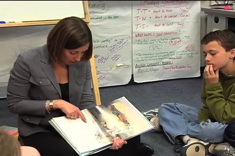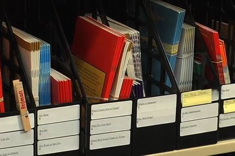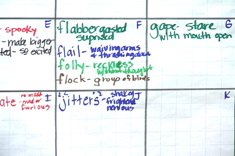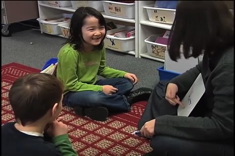As we work with teachers and students in classrooms to plan small-group lessons for at-risk readers, we notice a recurring pattern. Many students can say a particular phonetic rule like silent e makes the vowel say the long vowel sound, yet when the teacher analyzes the student’s running records or listens to the child read, the student does not consistently apply these phonetic rules when reading unfamiliar text.
We find that without repeated lessons that explicitly teach and support students in learning how to apply knowledge of letter sounds, many children do not independently transfer this knowledge when reading independently. Students need explicit modeling and guidance from their teachers as well as time to practice in order to internalize this new learning. As Regie Routman states in Reading Essentials, “If kids can’t apply what we teach them, our teaching is a big So What? I ask myself So what? All the time. How is this activity or strategy helping students become more competent and independent as learners?”
Here is a lesson plan template that we designed to support teachers as they model and guide their students to actively apply phonics rules when reading independently.
Part I: Warm Up (2-3 Minutes)
The warm-up activity is simply a quick review of the phonetic concepts that the students have been taught, but have not fully mastered. To begin, we select a few letter or sound cards from the classroom phonics program that have been mastered as well as one or two concepts that we want to review. We make sure that these cards are the same ones that the classroom teacher, special education or reading teacher uses to teach phonics so that the teaching is consistent. Once we have our cards, it is time for a quick warm up. Here are two different ideas for warm-up activities:
1. The teacher shows the letter/sound cards one at a time and asks the children to say the letter name, sound, and key word. Sometimes we will show the cards and have the students answer all together, other times we might have several copies of the cards and have students work with a partner or we will show the cards to the students individually.
2. The teacher says a sound, a letter name, or a key word. Then the students point to the appropriate letter card or write the letter. The students might write the letter in sand, in the air, on a whiteboard, or on paper. Either way this warm up is simply the reverse of step one.
What is essential about the warm-up?
1. Choose the phonetic concepts carefully. We want children to feel successful so we focus on a few known concepts and a few partially known concepts. We change the cards as the children master the concepts.
2. Keep it brief. The purpose of the warm up is to review concepts that have been previously taught. We want to spend the majority of our time teaching students, so we only review for 2-3 minutes.
3. Check for understanding. The warm up is a great way to check for understanding so that we know which concepts the students know in isolation, and which concepts they need to review. Pay attention and record what children need to learn so that tomorrow’s lesson can be refined.
Part II: Phonics (3-5 Minutes)
After the warm up is completed, we explicitly teach the children one phonetic concept that they need to learn. During these five minutes, we tell the students the phonetic rule and model how the phonetic rule works. The tools for this portion of the lesson can be quite simple: a whiteboard or chart paper or letter tiles are all a teacher needs. We generally alternate between teaching the students how to apply the phonetic concept when blending sounds together, and how to use the phonetic concept when writing a word.
What is essential about the phonics portion of the lesson?
1. Model. This is our chance to teach, so we focus on explicitly modeling the phonetic concept, rather than asking the students questions or asking them to complete a worksheet.
2. Keep it brief. Students can only pay attention for a short period of time, so we model a few times and move on. We know we will repeat this instruction during tomorrow’s small-group lesson.
PART III: Strategy Teaching (5-7 minutes)
The ultimate goal of all phonics instruction is to teach children to read and write, and here is our chance to show the students how to apply this concept in their literate lives. Depending on the student’s reading level and his or her use of reading strategies, we model how to use the phonetic concept when reading authentic text. We choose this strategy based on our analysis of the student’s running record and our conference notes.
Some of the strategies we may teach include:
- Look at the first letter in a word and say the sound. Look at the picture to think about what would make sense.
- Look for chunks in a word (th, ing, ea, tion). Put the parts together and reread to see if it makes sense.
- Blend the sounds together and reread to see if it makes sense.
We begin by modeling for the students how to use the phonetic concept when reading real text, so we use authentic text to model. A student’s independent reading book, an instructional level text, a poem, or big book can all be effective. After we have modeled a few times, we want the students to try applying the phonetic concept as we guide them. Students generally partner read a book that we have selected, or try applying the strategy to a book they are currently reading. We want the students to try applying this knowledge while we can guide them before they work independently.
What is essential about strategy teaching?
1. Accessing recent student assessment data. Use assessment data to choose a reading strategy that the student needs to learn.
2. Teaching using authentic texts. Model how to use the phonetic concept when reading.
3. Keeping meaning at the forefront. Always teach the children to monitor for meaning, so that they know that their reading must make sense. We need to make that explicit in every lesson.
4. Keep it brief. Show children how to apply the strategy and then let them try it. Students need a chance to practice as we coach and instruct while they work.
Part IV: Independent Practice (5-10 Minutes)
Since our goal is to have the students apply what they learned when they are reading, then we need to let the students practice reading independently. We believe the best texts are their independent reading books. During independent practice, we do not ask the students to search for a particular phonetic pattern because that isn’t what real readers do. Instead, we encourage the students to apply the strategy we modeled (use chunks, look at the first letter, or blend the sounds). Students will not just be practicing one phonetic skill, but more importantly thinking about all of the phonetic concepts they have learned and trying to make meaning. The children often complete a small portion of their silent reading right in the small group with us. As the children read, we confer and continue to teach, guide, and check for understanding.
What is essential about independent practice?
1. Giving enough time to students. Children need time to actually practice and the teacher needs time to observe the students reading to assess what children have learned and to confer as students work independently.
2. Matching books to readers. It is essential that the students have books that they can read independently, as well as texts that provide opportunities to practice the reading strategies they have learned.
3. Guiding and checking. As the students work independently, teachers can coach students as they read and take notes on which strategies students are applying independently.
Although we may vary the warm-up activities and the phonetic concept that is taught, we continue to teach all of our small groups using the gradual release of responsibility model. Douglas Fisher and Nancy Frey advocate for lessons based on the gradual release of responsibility. They state that in order to improve student learning, students need to be given an “increasing amount of responsibility to work on or complete an assignment independently on the basis of multiple iterations of guided instruction alternating with and informed by checks for understanding throughout a lesson.” We always want to keep in mind that our goal in teaching phonics is to help students learn how their knowledge of letter sounds and phonetic rules help them to construct meaning while reading.










